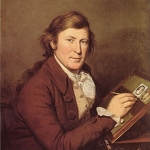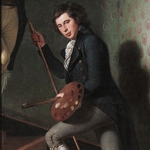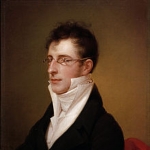Background
Charles Willson Peale was born on April 15, 1741 in Chester, Maryland, United States. The son of Charles Peale and his wife Margaret. He had a younger brother, James Peale (1749-1831).

inventor naturalist painter politician scientist Soldier
Charles Willson Peale was born on April 15, 1741 in Chester, Maryland, United States. The son of Charles Peale and his wife Margaret. He had a younger brother, James Peale (1749-1831).
A the age of 13, Peale became apprenticed to a saddler.
Besides, he studied for a time under John Hesselius and John Singleton Copley; and in 1767-1770 he studied under Benjamin West in London.
As a young man, Peale worked as a saddler, watchmaker, and silversmith. Bur he decided at the age of twenty-one that painting might be more profitable than saddlemaking, and took up painting.
In 1770 he opened a studio in Philadelphia, and met with immediate success. In 1772 he painted the first ever done portrait of George Washington. Peale had such great success as a Portraitist just prior to the Revolution that he was able to move his business to Philadelphia. Peale served with distinction in the Revolution. As a first lieutenant in the militia, he crossed the Delaware with Washington and spent the dreadful winter at Valley Forge, where he did miniatures of some 40 officers. He gained the intimate friendship of Washington, Benjamin Franklin, and Thomas Jefferson. He painted various other portraits of Washington; probably the best known in a full-length, which was made in 1778, and of which Peale made many copies.
He also served in the Pennsylvania state assembly in 1779-1780, after which he returned to painting full-time. In 1781 Peale added an exhibition gallery to his Philadelphia studio, where he housed 44 of his portraits of outstanding American leaders.
A commission to make drawings of bones of a prehistoric creature from the banks of the Ohio River gave Peale the idea of establishing a natural history museum. He opened his museum, the first museum not just for specialists and connoisseurs, opened to the general public in Philadelphia in 1786. It featured the earliest display of animal and other specimens in their natural settings and thus was the forerunner of the modern museum of natural history. Peale made his own finds, mounted them himself, and even devised an improved method of taxidermy to make the exhibits more lifelike. Peale fought to have his museum established as a state institution, and in 1802 it was transferred to the upper floor of the State House (the present Independence Hall).
Moreover, Peale established the Columbianum in 1795, America's first public exhibition of both modern paintings and the Old Masters. He was also a founder of the Pennsylvania Academy of the Fine Arts which received its charter in 1806 and which stands today as the oldest art school in the United States.
Besides, in 1812 Peale wrote “An Essay to Promote Domestic Happiness”, a tract that scholars today believe may have influenced many of his portrait compositions, in which family members touch intimately and are posed in a relaxed, informal manner.
Charles Willson Peale died on February 22, 1827 in Philadelphia, Pennsylvania, United States.
Peale is best remembered for his portrait paintings of leading figures of the American Revolution. He painted about 1,100 portraits, including sitters such as George Washington, Benjamin Franklin, Thomas Jefferson, and John Adams. Peale is also famous for establishing the first scientific museum in the United States in 1786.
Moreover, the World War II cargo Liberty Ship S. S. Charles Willson Peale was named in his honor.
Julia Stockton (Mrs. Benjamin) Rush
Mrs. Thomas Leiper and Her Daughter, Helen Hamilton Leiper
Mother Caressing Her Convalescant Daughter
Henrietta Maria Bordley
Portrait of Raphaelle Peale
Nathaniel Ramsay
Arthur St. Clair
John Beale Bordley
Henry Knox
Self Portrait
James Peale Painting a Miniature
Benjamin and Eleanor Ridgley Laming
The Stewart Children (also known as Isabella and John Stewart)
Portrait of a Maryland Gentleman
Joseph Brant
View of West Point from the Side of the Mountain
Mrs. John Dickenson and Her Daughter
Edward Burd
Mordecai Gist
Portrait of William Harris Crawford
Governor Thomas McKean and His Son, Thomas, Jr.
The Artist's Mother, Mrs. Charles Peale, and Her Grandchildren
Robert Goldsborough and Family
Margaret Strachan (Mrs. Thomas Harwood)
George Washington
Noah and His Ark (after Charles Catton)
Mrs. James Smith and Grandson
Mrs. Thomas Ellott (Mary Chase)
George Washington (1732–1799), as Colonel Commander of the Virginian Colonial Troops
Titian Ramsay Peale
Thomas Elliott and His Granddaughter Deborah Hibernia
Self Portrait (also known as Study for 'The Artist in His Museum')
Portrait of Edmund Physick
Stephen Harriman Long
Mary O'Donnell
A Front View of Statehouse at Annapolis
Belfield Farm
The Peale Family
General Joseph Bloomfield
Portrait of James W. DePeyster
George Washington
Washington After the Battle of Princeton, New Jersey
View of the Garden at Belfield
The Staircase Group (also known as Raphael and Titian Ramsey Peale)
Charles Waterton
Cabbage Patch, The Gardens of Belfield, Pennsylvania
Self-Portrait
Thomas and Henry Sergeant
James Peale (also known as The Lamplight Portrait)
Nancy Hallam as Fidele in Shakespeare's Cymbeline
Robert Fulton (1765–1815)
Exhumation of the Mastadon
Charles Wilson Peale 1741-1827
Mr. and Mrs. Alexander Robinson
George Washington
Rachel Weeping
Mrs. John O'Donnell (Sarah Chew Elliott)
Portrait of Colonel John Cox
John Cadwalader Family
Millbank
Landscape Looking Towards Sellers Hall from Mill Bank
William Smith and His Grandson
Benjamin Lincoln
Charles Pettit
During the American Revolution, Peale, a zealous patriot, served as a militia officer in the campaign of Trenton and Princeton (1776-1777) and the defense of Philadelphia (1777-1778); and as a “furious Whig” he took a prominent role in political controversies of the period.
Quotations: "The Learner must be led always from familiar objects toward the unfamiliar, guided along, as it were, a chain of flowers into the mysteries of life."
Peale had a great interest in natural history.
In 1762, Peale married Rachel Brewer (1744-1790), who bore him ten children, most named for Peale's favorite artists, male and female. The sons included Raphaelle Peale (1774-1825), Rembrandt Peale (1778-1860) and Rubens Peale (1784-1865). Among the daughters: Angelica Kauffman Peale (named for Angelica Kauffman, Peale's favorite female painter) and Sophonisba Angusciola Peale (named for Sofonisba Anguissola).
After Rachel's death in 1790, Peale married Elizabeth de Peyster (d. 1804) the next year. With his second wife, he had six additional children. Among them was Franklin Peale, born on October 15, 1795, became the Chief Coiner at the Philadelphia Mint. Their youngest son, Titian Ramsay Peale (1799-1885), became an important naturalist and pioneer in photography. Their daughter, Elizabeth De Peyster Peale (1802-1857), married William Augustus Patterson (1792-1833) in 1820.
Hannah More married Peale in 1804, becoming his third wife. She helped raise the younger children from his previous two marriages.

James Peale (1749-1831) was a younger brother of Charles Willson Peale.

She died in 1790.

He is considered the first professional American painter of still-life.
He was a famous portrait painter and museum keeper in Baltimore.

She was named for Angelica Kauffman, Peale's favorite female painter. She was married to Alexander Robinson.
She was named for Sofonisba Anguissola (Italian Renaissance). She was married to Coleman Sellers.

She died in 1804.

He was born on October 15, 1795, became the Chief Coiner at the Philadelphia Mint.
Titian Ramsay Peale (1799-1885) became an important naturalist and pioneer in photography.
Elizabeth De Peyster Peale (1802-1857) married William Augustus Patterson (1792-1833) in 1820.
She was a Quaker from Philadelphia.
Peale's slave, Moses Williams, was also trained in the arts while growing up in the Peale household and later became a professional silhouette artist.
